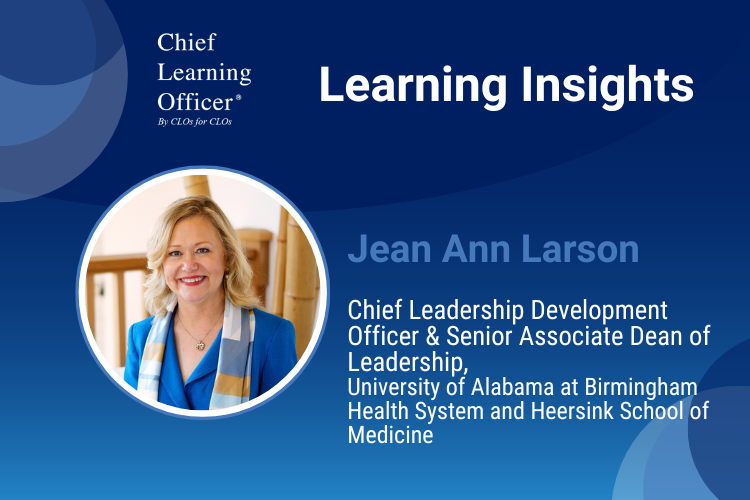Chief Learning Officer’s “Learning Insights” series is dedicated to showcasing the thoughts and career journeys of chief learning officers and learning executives—the tireless trailblazers who are transforming the landscape of corporate learning and workforce development. In this Q&A series, we garner strategic insights, innovative approaches and challenges overcome from visionary leaders worldwide.
CLO: What initially drew you to a career in learning and development, and how have your experiences evolved over the years?
I came from a background in process improvement and process engineering, (my undergraduate degree is in engineering) teaching and facilitating teams to help them improve their processes and ways of working together. I quickly learned that improvement went far beyond the tools and techniques and that individual and team development were just as important. As I moved through the organization and became an operations executive, I saw firsthand how leadership skills can make or break a team or an organization. Then in 2001, I was asked to develop a corporate university for a large health system with over 20,000 employees in the Detroit Metro area. I was in that role for 10 years.
At that time, I also went back for my doctorate in organizational change and leadership at Pepperdine University. The formal education further shaped my thinking around the importance of lifelong learning. After that, I moved to a children’s hospital in Dallas, learning even more deeply how important good leadership is to ensuring patient safety and quality. (I was the VP of patient safety and quality.) After that, I founded my own boutique leadership development consulting firm serving health care, retail and defense industry clients. From there I was recruited to UAB to be the chief leadership development officer focused on developing and supporting senior leaders in the school of medicine and the health system. I’ve been here for eight years all the while building a small but mighty team.
We have created and delivered 16 formal leadership programs as well as providing organization development engagements, executive coaching and the design and delivery of well over 25 retreats a year. I feel like my career has led me here to my current role as chief leadership development officer and senior associate dean of leadership development, and I have come full circle. In addition to my chief leadership development officer role, I am adjunct faculty teaching in the School of Health Professions in the number one program in health care administration, and I also teach in the UAB quality academy.
Both of these are graduate-level programs. One of our most exciting new offerings is working with physicians, nurses and operation people to teach quality improvement leadership teams to work together to effectively lead the care units that they are responsible for. We call it the “High Performing Care Collaborative.” Through this program, we are seeing improved patient outcomes, improved employee engagement and a reduction in caregiver burnout. And we’ve only begun the journey.
CLO: What key initiatives have you implemented as a learning leader to drive employee development and foster a learning culture?
Our programs started at the senior leader level. However, within these programs, a critical piece of learning and through many practical assignments, we require participants to develop and sponsor the learning of their direct reports. This allows us to leverage our small team while pushing a learning culture throughout the organization. Specific key initiatives include: The High Impact Leadership series (for leadership teams) the High Performing Care Collaborate for care team leaders and the Momentum Leaders in Medicine at UAB (a program geared toward senior female leaders since we are a largely female organization.) In addition, we have programs geared toward emerging leaders, junior female faculty, mid-level faculty and soon medical students.
CLO: What is the most impactful learning program you’ve introduced in your organization, and how has it contributed to employee growth and business success?
This is a tough question. I feel that the whole of what we do is more than the sum of all its parts, particularly as we are evolving our culture. The high-performing care collaborative is contributing to team learning which translates directly to better patient care. We think we are doing some innovative approaches that will improve the organization as well as contribute to the literature offering what we have learned to healthcare providers around the world. Our high-impact leadership series has made it safe for the highest leaders to come together and learn together. They are seeing it as an investment in them. These and our other programs serve as recruitment and retention tools.
CLO: What is a common misconception people might have about the L&D function, and how do you address it?
I think that people don’t appreciate that learning and development professionals usually come from a very grounded and experiential place. What we do is not just based on theory. It is based upon our experiences and observations and comes from our passion. We are intrinsically motivated to help people realize their amazing potential… sometimes before they do.
CLO: What excites you the most about the future of workplace learning, and how are you preparing your organization to adapt to the changing landscape?
I am excited about other modalities of learning as well as the use of AI tools. I am a student of languages and I have found applications such as Duolingo to be game-changing. The AI portion of that allows me to endlessly practice on the areas that I need to practice. We are championing AI tools and much more online learning such as LinkedIn learning to help our learners become much more autonomous in developing.
CLO: What essential qualities or skills make a successful L&D leader, and how do you cultivate these traits in yourself and among your team?
One is that you have to believe in people and see potential in all of them. My mantra is that people are creative, capable and complete. My job is to remind every learner of this truth. In addition, we must be lifelong learners and model this for our teams and our stakeholders. I also think that my curiosity helps fuel my passion so I would say that curiosity is important.
CLO: What game-changing advice would you offer if you could go back in time and mentor your younger self?
My career path, like many, has been quite circuitous. My advice would be, “Don’t be afraid to make the jump and lean into the new opportunities.” I eventually got there but sooner might have been better. I’d also say, don’t worry about what others say or even what their advice is (Including mine! Ha!) Do what is right for you.
CLO: What do you feel is currently the single biggest challenge facing L&D professionals and the industry as a whole?
As always, it is making sure and reminding people that L&D is not a luxury. Everyone talks about investing in people and the importance of developing them for the success of the company. However, when there is a downturn, it may be one of the first areas to cut. A second challenge is to help people stay ahead of the technology so that they can be comfortable and competent users of that technology.
CLO: We’re always looking to showcase innovative tools and technologies. Can you share one work or learning tech product or platform that has significantly improved your work processes and why you find it valuable?
I don’t have anything to share at this point, but I may in the future!
Interested in being featured in our “Learning Insights” series? Please complete this FORM.















